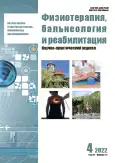Recovery of anti-gravity muscles in patients with consequences of limb injury
- Authors: Somov D.A.1, Makarova M.R.1, Maiorov E.A.1
-
Affiliations:
- Moscow Centre for Research and Practice in Medical Rehabilitation, Restorative and Sports Medicine
- Issue: Vol 21, No 4 (2022)
- Pages: 237-244
- Section: Original studies
- URL: https://journals.rcsi.science/1681-3456/article/view/131071
- DOI: https://doi.org/10.17816/rjpbr114786
- ID: 131071
Cite item
Abstract
BACKGROUND: Over the past years, injuries have been consistently included in the first seven leading classes in the structure of general morbidity, and in the distribution of the number of people aged 18 years and over who were first recognized as disabled, they are included in the first six causes of disability.
AIM: to study the clinical efficacy and safety of the author's technique, in patients after injuries of the lower and upper extremities at the second stage of medical rehabilitation.
MATERIALS AND METHODS: The study included 105 patients who had suffered injuries. 37 (35.2%) men, 68 (64.8%) women. The patients were randomly divided into 2 observation groups: the main group (n=53), whose patients, in addition to the standard rehabilitation program, were trained on the biofeedback simulator Tergumed Pegasus 3D (Germany), a course of 7–10 procedures, and the control group (n=52), whose patients underwent a course of medical rehabilitation only according to the standard program of the 2nd stage, lasting 10–14 days. The complex rehabilitation treatment of patients included standard drug therapy, massage courses, physiotherapy, group exercise therapy. Treatment outcomes were assessed using the VAS (Visual Analog Scale), HAQ (Health Assessment Questionnaire), Lequesne index, and 20-m walking time scales. Data analysis included comparison of dependent series of variables and descriptive statistics methods. The type of data distribution (parametric or nonparametric) was assessed using the Shapiro–Wilk and Kolmogorov–Smirnov tests. The statistical significance of differences between dependent groups was assessed using the Wilcoxon and Mann–Whitney tests. The value of p=0.05 was taken as the level of statistical significance.
RESULTS: All measured indicators improved significantly (p <0.001). In the main group, compared with the control group, there was a statistically significant increase in walking speed, and there was a tendency to a more pronounced positive change in the Lequesne and HAQ indices, the level of pain according to VAS, compared with the control group.
CONCLUSION: Our proposed method of training with the participation of antigravity muscles trunk is effective for patients after limb injuries at the 2nd stage of medical rehabilitation.
Keywords
Full Text
##article.viewOnOriginalSite##About the authors
Dmitry A. Somov
Moscow Centre for Research and Practice in Medical Rehabilitation, Restorative and Sports Medicine
Email: docsomov@bk.ru
ORCID iD: 0000-0002-3245-167X
SPIN-code: 9380-4174
MD, Cand. Sci. (Med.), Senior Research Associate
Russian Federation, MoscowMarina R. Makarova
Moscow Centre for Research and Practice in Medical Rehabilitation, Restorative and Sports Medicine
Author for correspondence.
Email: makarovamr.mrm@yandex.ru
ORCID iD: 0000-0002-1787-7015
SPIN-code: 7640-4570
MD, Cand. Sci. (Med.), Leading Researcher
Russian Federation, MoscowEgor A. Maiorov
Moscow Centre for Research and Practice in Medical Rehabilitation, Restorative and Sports Medicine
Email: smotrinao@gmail.com
ORCID iD: 0000-0001-6754-5214
SPIN-code: 2357-8306
postgraduate student
Russian Federation, MoscowReferences
- Haagsma JA, James SL, Castle CD, et al. Burden of injury along the development spectrum: Associations between the Socio-demographic Index and disability-adjusted life year estimates from the Global Burden of Disease Study 2017. Inj Prev. 2020;26 (Suppl 1):i12–i26. doi: 10.1136/injuryprev-2019-043296
- Healthcare in Russia. Statistical collection. 2021. Moscow: Rosstat; 2021. 171 р. (In Russ).
- Aghajanyan VV, Kravtsov SA, Shatalin АV, Levchenko TV. Hospital mortality in polytrauma and the main directions of its reduction. Polytrauma. 2015;(1):6–15. (In Russ).
- Li K, Ackland DC, McClelland JA, et al. Trunk muscle action compensates for reduced quadriceps force during walking after total knee arthroplasty. Gait Posture. 2013;38(1):79–85. doi: 10.1016/j.gaitpost.2012.10.018
- Oshima Y, Watanabe N, Iizawa N, et al. Knee-hip-spine syndrome: Improvement in preoperative abnormal posture following total knee arthroplasty. Adv Orthop. 2019;2019:8484938. doi: 10.1155/2019/8484938
- Stevens VK, Parlevliet TG, Coorevits PL, et al. The effect of increasing resistance on trunk muscle activity during extension and flexion exercises on training devices. J Electromyogr Kinesiol. 2008;18(3):434–445. doi: 10.1016/j.jelekin.2006.10.009
- Sasaki A, Milosevic M, Nakazawa K. Cortical and subcortical neural interactions between trunk and upper-limb muscles in humans. Neuroscience. 2020;451(15):126–136. doi: 10.1016/j.neuroscience.2020.10.011
- Patent RUS № RU 2758631 C1. Somov DA, Makarova MR, Pogonchenkova IV, et al. Method of treatment and prevention of back pain by isometric barefoot training of patients after endoprosthetics of the joints of the lower extremities. (In Russ). Available from: https://yandex.ru/patents/doc/RU2758631C1_20211101. Accessed: 15.07.2022.
- Prokopenko SV, Abroskina MV, Ondar VS, Kaigorodtseva SA. A variant of expert evaluation of balance and walking functions in stroke patients. Medical Social Expert Evaluation and Rehabilitation. 2017;20(4):176–180. (In Russ). doi: 10.18821/1560-9537-2017-20-4-176-180
- Bernstein NA. General biomechanics. Fundamentals of the doctrine of human movements. Moscow; 1926. 416 р. (In Russ).
- Wilczyński J, Kasprzak A. Dynamics of changes in isometric strength and muscle imbalance in the treatment of women with low back pain. Biomed Res Int. 2020;2020:6139535. doi: 10.1155/2020/6139535
- Khakimov SA. Complex application of innovative kinesotherapy and manual therapy in lumbosacral dorsopathy [dissertation abstract]. Moscow; 2011. 36 p. (In Russ).
- De Ridder E, Danneels L, Vleeming A, et al. Trunk extension exercises: How is trunk extensor muscle recruitment related to the exercise dosage? J Electromyogr Kinesiol. 2015;25(4):681–688. doi: 10.1016/j. jelekin.2015.01.001
Supplementary files






